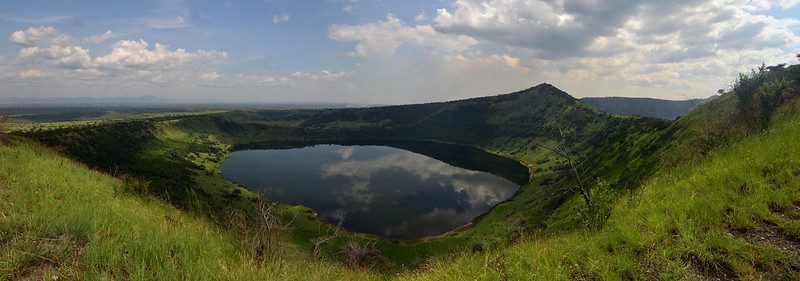Discover Uganda Crater Lakes
Explore Uganda’s Crater Lakes: Known as “The Pearl of Africa,” Uganda is endowed with more than 50 crater lakes that are characterized by a certain atmosphere and beauty. The western rift valley region, sometimes referred to locally as the Ndali-Kasenda crater region, is home to the majority of these crater lakes. This area is primarily situated between Mount Rwenzori National Park, Queen Elizabeth National Park, and Kibale National Park. The stunning scenery and vistas that surround these crater lakes will make a safari in Uganda very exhilarating and unforgettable.
One can customize or design a combined Uganda crater lakes safari while on a safari in Uganda to fully experience the natural beauty and rich cultural heritage of these lakes.Another benefit is that some Ugandan national parks have crater lakes.
For instance, Kibale National Park, Queen Elizabeth National Park, and Mount Rwenzori National Park are known for having a large number of crater lakes, some of which are volcanic crater lakes and others of explosion craters. As a result, one can add a crater lake safari package to their Uganda wildlife safari to make the experience even better.
However, these crater lakes can also be freshwater lakes, such as the twin lakes Kyema and Kamweru, Miramba and Katinda, Nyungu and Rwizongo, and Lake Nkuruba, which primarily serve as drinking places for wild animals and some pirates.
Other examples of crater lakes that can have a strong odor include Katwe Crater Lake, which is located south of Queen Elizabeth National Park where salt mining occurs, and Bunyaruguru Crater and Ndali Kasenda crater lake fields found along the western arm of the rift valley. Additionally, these contain rich soils that encourage the growth of plants like Arabica coffee, making them an excellent choice for Ugandan agrotourism safaris, particularly those that explore western Uganda.
The following are Uganda’s principal crater lakes:
Lake Katwe Crater
Located in the western region of the country, in the Kasese section of Queen Elizabeth National Park, this hypersaline lake is roughly 413 kilometers from Kampala and 431 kilometers from Entebbe. However, the western rift valley’s volcanic activity is the cause of it, and salt mining is the main industry that continues there.
During a Uganda wildlife safari at Queen Elizabeth National Park, visitors can enjoy a stunning Uganda crater lake safari with a rich cultural experience, particularly from the salt-mining women who share their life stories and how they go about their daily lives.
The dry months of January, February, June, August, and September are the ideal times to explore Lake Katwe on a Uganda safari. These months are also the best times to see wildlife in Queen Elizabeth National Park and go salt mining.
Fields of Bunyaruguru Crater
The twin lakes of Kyema and Kameron, Marimba and Katinda, Lake Nougat, Lake Nyungu, Lake Rwinzogo, and Lake Kibwama are among the more than 20 crater lakes in this region. situated in the Kichwanba escarpment region of the west rift valley in western Uganda; some of these lakes are next to one another and provide picturesque views; Uganda wildlife safaris, particularly those that observe the hundreds of hippos found in Lake Kibwama; and lovely vegetation, which is characterized by green savannah vegetation, among other things.
Although safaris are available all year round, the best time to visit Bunyaruguru Crater Field is during the dry season, which includes January, February, June, August, and December. This is because most animals and birds congregate in these lakes to drink water, and tracking paths are easier to reach during this time.
Explore the Ndali-kasenda crater fields
Ndali Crater Fields, a volcanic area adjacent to Queen Elizabeth National Park, is a great place to go on a Uganda wildlife safari or safari. It has many crater lakes, such as Lake Kasenda, Lake Kyantonde, Lake Nkuruba, Lake Nyabikere, and Lake Kifuruka, among others, with stunning scenic views and opportunities for both Uganda wildlife and birding safaris.
The dry season, particularly the months of December, January, February, June, July, and August, is the ideal time to explore Ndali-kasanda because tracking pathways are easier to access during this period, allowing a Uganda safari
Explore the Fort Portal Crater Lakes in Uganda.
Located in the Kabarole district of western Uganda, they are well-known for their boat cruises and Uganda bird viewing options, in addition to its stunning scenery and hiking opportunities. Fort Portal might be a fantastic location for birdwatching and Uganda wildlife excursions. Lake Nyabikere, Lake Lyantonde, and Lake Nkuraba are some of these lakes. Due to their rich soil, which supports the growth of plants like Arabica coffee, as well as the opportunity for lovely cultural exchanges, these are beneficial for Uganda’s agrotourism industry.
Explore the Kibale Crater Lakes in Uganda.
These are primarily found in the vicinity of Kibale National Park in western Uganda, and for those who are on a Uganda wildlife safari there—which primarily involves gorilla trekking—this would be a lovely bonus to their safari because some of the crater lakes here serve as watering grounds for primates like gorillas. For instance, Lake Nyinambuga, which has fresh, clean water and is home to a variety of primates, including monkeys and baboons, is also featured on the 20,000 Uganda shilling note.
The dry months of January, December, February, June, July, and August are the ideal times to visit the Kibale Lakes, particularly during a Uganda safari. This is because the tracks are easy to follow and it is easier to view wild animals during these months, making a Uganda wildlife safari a stunning experience.



